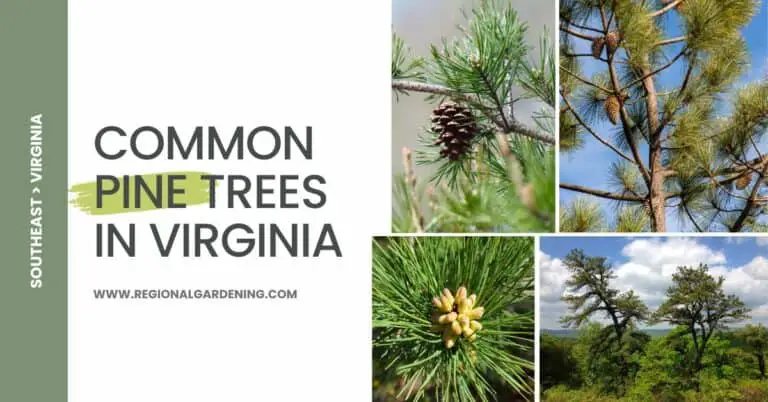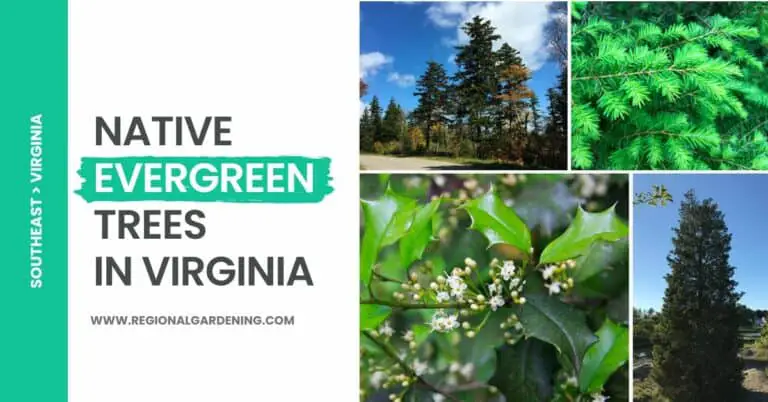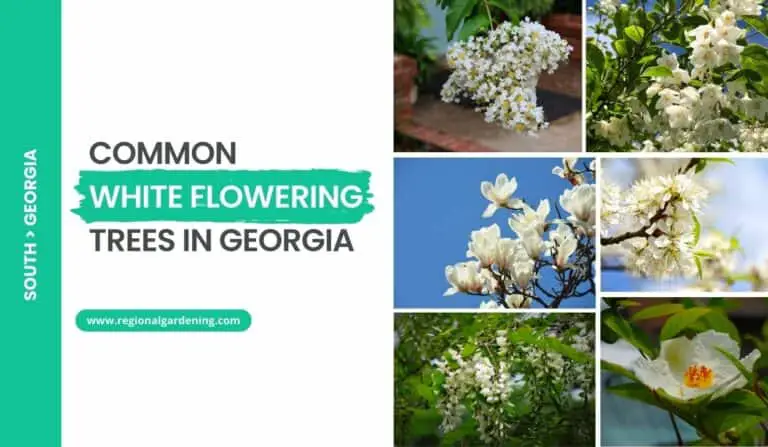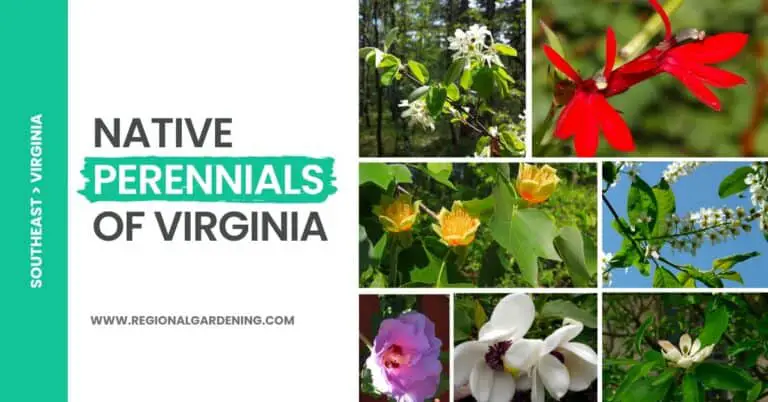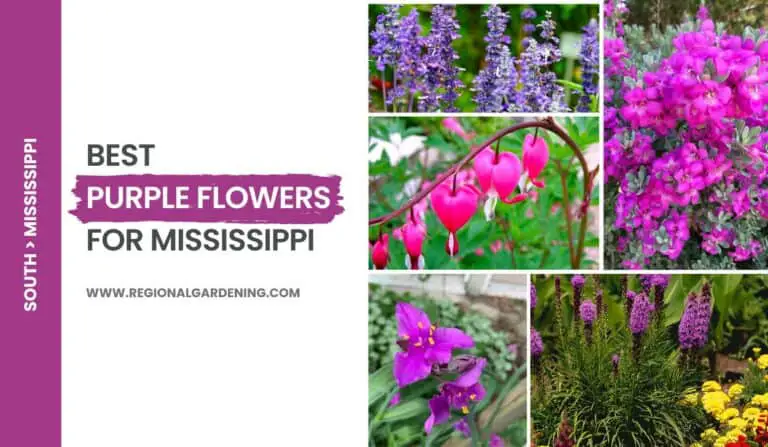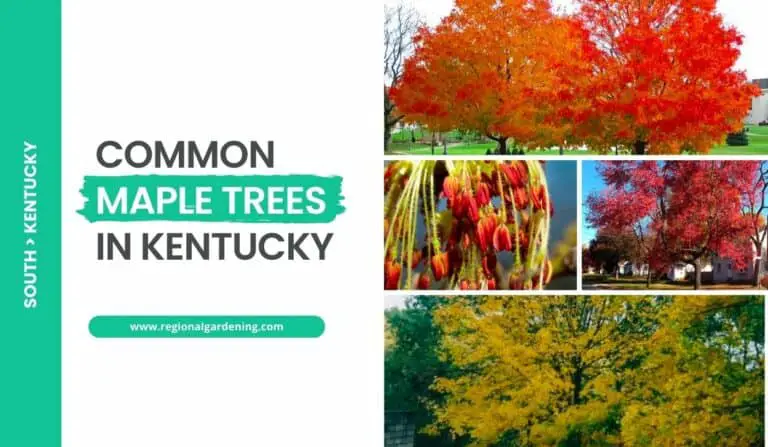15 Common Palm Trees In Georgia (Photos & Care Tips)
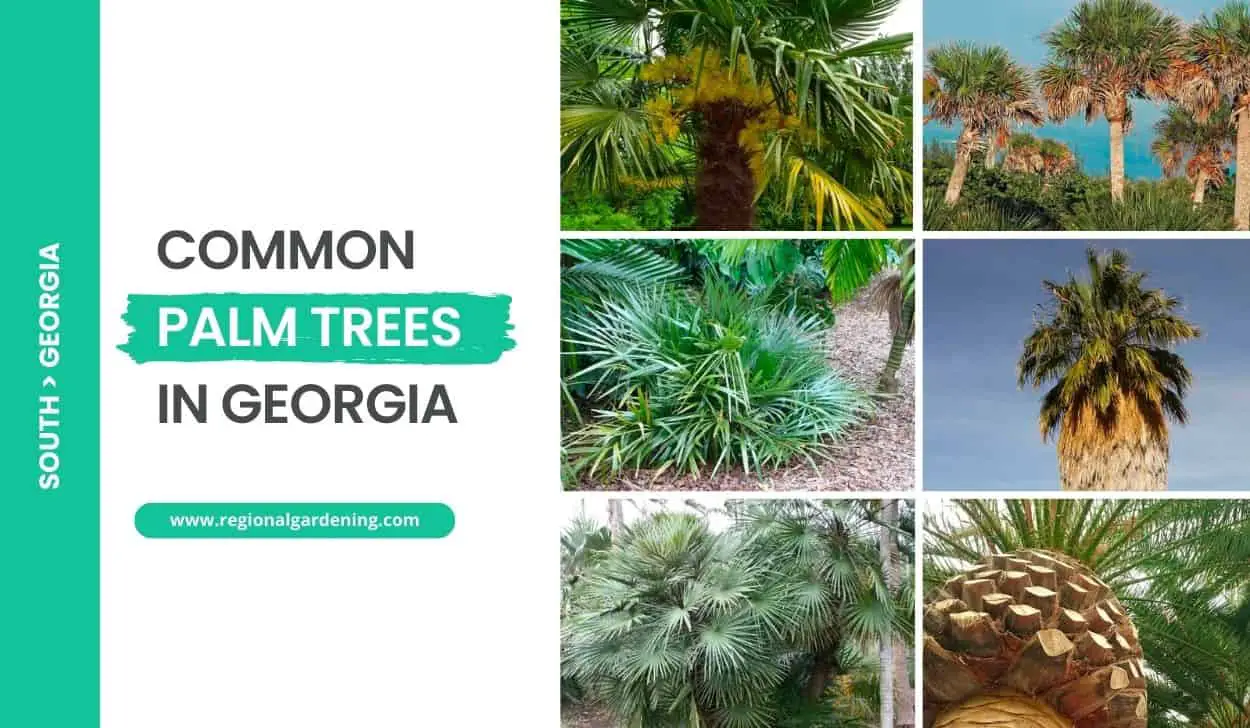
When you think of luxury hotels and resorts, the first thing that comes to mind is palm trees lining a pathway. And, if you live in Georgia and are looking to add some of them to your backyard, this is the place to be.
In this article, we will go through 16 of the most commonly grown palm trees in Georgia. Each tree comes with a high-quality photo and a detailed description, allowing you to easily select the best one for your landscape.
So, let’s begin.
1. Date Palm
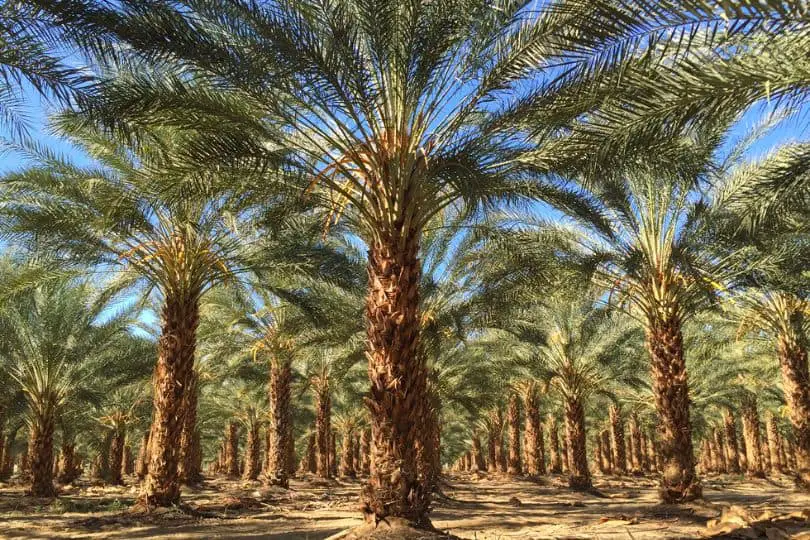
- Scientific Name: Phoenix dactylifera
- Common Name(s): Date Palm
- Mature Height: 50-75 feet (15-23 meters)
- Native Region: Middle East and North Africa
- Flowers: Small, yellowish flowers
- Fruit: Edible dates
- Uses: Landscaping, fruit production, shade tree, ornamental tree
The Date Palm (Phoenix dactylifera) is a large tree that can grow to be 50 to 75 feet (15 to 23 meters) tall when mature. It’s from the Middle East and North Africa. The tree has a single trunk and huge feather-like leaves that can reach a height of 20 feet (6 meters). The Date Palm’s bark is rough and grayish-brown in color.
The Date Palm is commonly planted in Georgia settings as an aesthetic tree or for its fruit production. It can give shade while also adding a tropical or Mediterranean feel to the area. To thrive, the tree requires full light and well-drained soil. It can withstand drought conditions, although it grows best when watered regularly.
The Date Palm has little, yellowish blossoms that are unobtrusive and unshowy. The Tree is dioecious, which means that male and female blooms grow on distinct plants. Female trees bear the well-known fruit known as dates. The fruit is oval or cylindrical and turns from green to yellow or reddish-brown when ripe. Dates are a popular sweet fruit that is utilized in a variety of culinary recipes due to their high sugar content.
The Date Palm has cultural and historical significance in addition to its landscape and fruit-producing functions. It is one of the oldest cultivated trees, having been grown for thousands of years throughout the Middle East. The tree is economically significant in date-growing countries, where dates are both a staple food and a considerable export. The trunk of the Date Palm is utilized in construction, while the leaves are frequently used in handicrafts and baskets.
2. Cabbage Palm
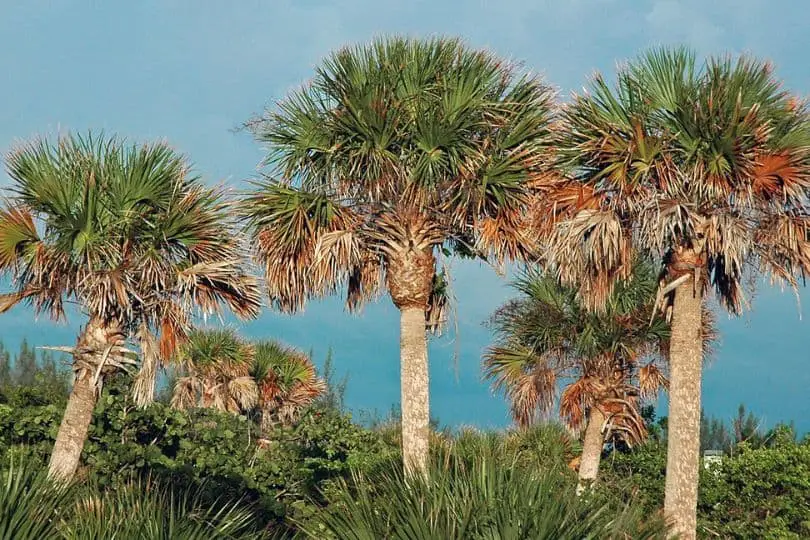
- Scientific Name: Sabal palmetto
- Common Name(s): Cabbage Palm, Sabal Palm
- Mature Height: 40-80 feet (12-24 meters)
- Native Region: Southeastern United States, including Georgia
- Flowers: Cream-colored flowers in large clusters
- Fruit: Black, spherical fruit
- Uses: Ornamental tree, coastal landscaping, source of cabbage palm hearts for culinary purposes, and traditionally used for thatching and construction materials.
The Cabbage Palm, also known as the Sabal Palm or Sabal palmetto, is a tall and recognizable tree found in Georgia landscapes. It is native to the southeastern United States, particularly Georgia, and can reach mature heights of 40-80 feet (12-24 meters).
Cabbage Palm trees in Georgia are distinguished by their tall, slender trunks and fan-shaped leaves. The trunk is grayish-brown with a rough texture, and the lowest half of the tree grows barren as it ages. The leaves are huge and palmate, reaching up to 5 feet (1.5 meters) in diameter, giving it a tropical appearance.
Because it likes a warm and humid climate, the Cabbage Palm is mostly found along Georgia’s coast. It can withstand a variety of soil conditions, including sandy and salty soils, making it ideal for coastal landscaping. This tree is also extremely wind and salt-spray-resistant, making it suitable for coastal areas prone to storms and hurricanes.
The Cabbage Palm produces cream-colored blooms in enormous clusters during the blooming season, which is normally in late spring or early summer. Bees and other pollinators are drawn to these flowers. The tree also bears black, spherical fruit that is eaten by birds and wildlife.
Because of its decorative appeal, the Cabbage Palm is widely utilized in landscaping. It gives landscapes a tropical and exotic feel and can be planted as a focal point or in groupings. Because of its salt tolerance, it is a wonderful choice for coastal gardens. The soft inner section of the stem, known as the “heart of the palm,” is also edible and utilized in culinary applications. Cabbage Palm leaves were traditionally used for thatching and construction materials.
3. Windmill Palm
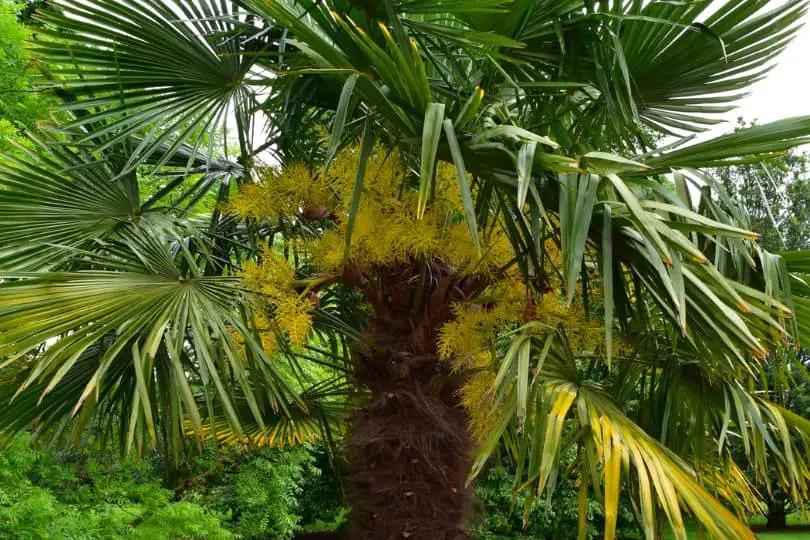
- Scientific Name: Trachycarpus fortunei
- Common Name(s): Windmill Palm, Chusan Palm
- Mature Height: 20-40 feet (6-12 meters)
- Native Region: East Asia (China, Japan)
- Flowers: Yellowish-white flowers arranged in clusters
- Fruit: Small blue-black berries
- Uses: Ornamental trees, commonly used in landscaping, can be grown in containers, great for creating tropical ambiance, providing shade, and adding a dramatic element to gardens.
The Windmill Palm (Trachycarpus fortunei) is a popular palm tree that may be seen in Georgia landscapes. Its tall, slender trunk and big, fan-shaped leaves distinguish it. This palm tree can grow to be 20-40 feet (6-12 meters) tall when mature, making it a spectacular addition to any landscape.
The Windmill Palm is native to East Asia, specifically China and Japan, and it thrives in Georgia’s environment. It can withstand cooler conditions, making it an excellent choice for people wishing to add a tropical flair to their gardens. The Windmill Palm grows in hilly locations, often at high elevations, in its natural range.
The Windmill Palm has yellowish-white flowers that grow in clusters. These blossoms add beauty to the tree while attracting pollinators like bees and butterflies. The Windmill Palm produces small, blue-black berries in late summer or early fall, giving another aesthetic element to its overall appearance.
The Windmill Palm grows best in well-drained soil and loves full sun to light shade in Georgia. Once grown, it is drought-tolerant, but constant watering is essential throughout the initial development stage. This palm tree requires little care and can tolerate both hot and cold climates, making it an excellent choice for Georgia landscapes.
Windmill Palms are frequently utilized in landscaping to create a tropical atmosphere. Its towering and graceful form adds drama to gardens, while its big leaves give shade and shelter. Furthermore, because this palm tree can be grown in pots, it is a versatile solution for individuals with little space.
4. Needle Palm
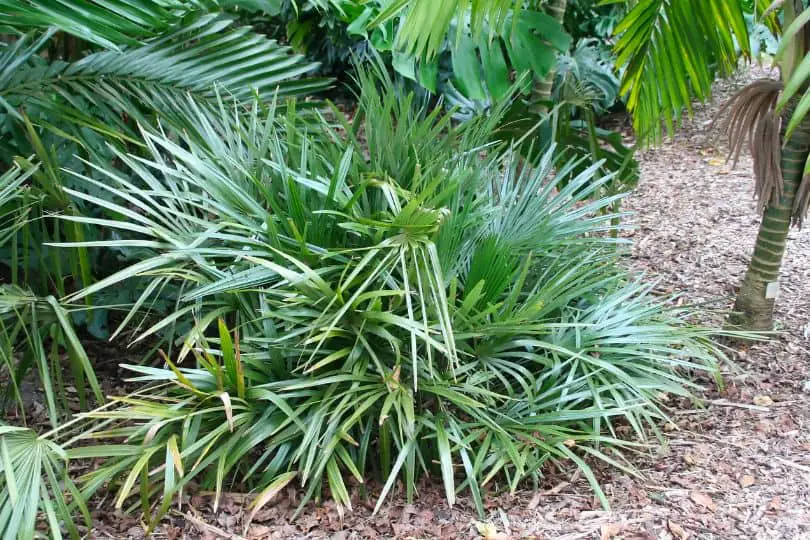
- Scientific Name: Rhapidophyllum hystrix
- Common Name(s): Needle Palm
- Mature Height: 6–10 feet (1.8-3 meters)
- Native Region: Southeastern United States
- Flowers: No Flowers
- Fruit: Small, blue-black berries
- Uses: Ornamental plants in gardens and landscapes
The Needle Palm, Rhapidophyllum hystrix, is a tiny and resilient palm tree that is widely seen in Georgia landscapes. It is a smaller palm tree species, growing to a mature height of 6-10 feet (1.8-3 meters). It is indigenous to the southeastern United States, which includes Georgia.
The Needle Palm is distinguished by its distinctive needle-like leaves, which are dark green and spread in a circular pattern from the trunk’s top. A dense fibrous mat of old leaf bases covers the trunk, giving it a rough and rustic appearance. The tree grows slowly and may take several years to reach its full height.
The Needle Palm thrives in well-drained soils and can survive a wide range of conditions in Georgia environments, from full sun to moderate shade. It is exceptionally cold-tolerant, withstanding temperatures as low as -20°F (-29°C), making it appropriate for planting in cold-weather settings. Once grown, the palm is also drought tolerant.
The Needle Palm does not produce blooms, but it does produce little blue-black berries that are appealing to birds. These berries can be seen on the tree all year. Aside from its decorative significance, the Needle Palm has few practical applications. Because of its tiny size and low maintenance needs, it is suitable for small gardens, rock gardens, or as a focus point in landscape designs.
5. Queen Palm
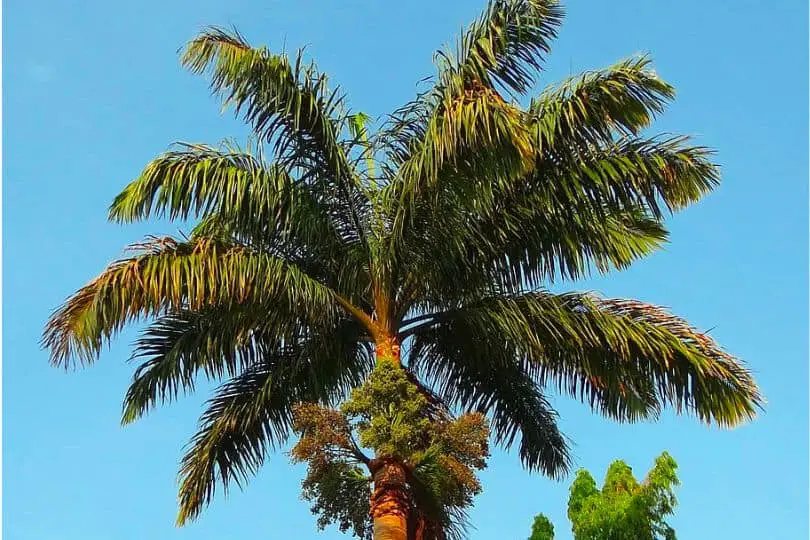
- Scientific Name: Syagrus romanzoffiana
- Common Name(s): Queen Palm
- Mature Height: 30-50 feet (9-15 meters)
- Native Region: South America (Argentina, Brazil, Uruguay)
- Flowers: Cream-colored flowers in large clusters
- Fruit: Small orange-yellow fruit
- Uses: Ornamental tree in parks, gardens, and landscapes; can be used as a street tree; provides
The Queen Palm (Syagrus romanzoffiana) is a popular palm tree that may be seen in Georgia landscapes. It is native to South America, notably Argentina, Brazil, and Uruguay, and can reach mature heights of 30 to 50 feet (9 to 15 meters). This palm tree is commonly grown for ornamental purposes in parks, gardens, and landscapes.
The Queen Palm can be identified by its feathery fronds that arch gently outwards. The fronds can reach a length of 10 to 15 feet, creating an exquisite and tropical appearance. The tree has a single, straight trunk that is smooth and grayish-brown in appearance. Its bark is normally smooth and without any identifiable patterns or markings.
Queen Palm trees in Georgia flourish in warm areas and prefer well-drained soil. They must be watered regularly, especially during hot and dry spells. These palms are recognized for their wind resistance and ability to withstand stormy circumstances. In colder climates, they may require some frost protection. Furthermore, the Queen Palm prefers full light but may tolerate moderate shade.
The Queen Palm produces huge clusters of cream-colored blooms on long stalks during its blooming season. These blooms provide a lovely display and attract pollinators like bees and butterflies. The tree also bears little orange-yellow fruits that are not frequently consumed by humans but provide food for birds and other wildlife.
Because of its beautiful look and tropical beauty, the Queen Palm is primarily employed as an ornamental tree in Georgia. It is frequently planted to beautify the landscape and give shade in parks, gardens, and along streets. The beautiful fronds and appealing blossoms of the palm make it a popular choice for creating a tropical mood in outdoor spaces. The Queen Palm, whether as a single specimen or in groups, provides a sense of elegance and exoticism to Georgia settings.
6. California Fan Palm
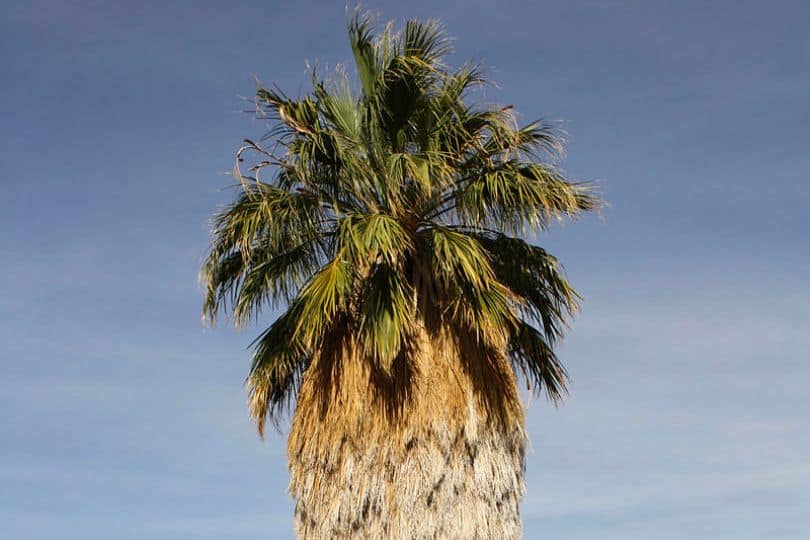
- Scientific Name: Washingtonia filifera
- Common Name(s): California Fan Palm, Desert Fan Palm
- Mature Height: 30-60 feet (9-18 meters)
- Native Region: Southwestern United States and Northwestern Mexico
- Flowers: Creamy-white, small, clustered flowers
- Fruit: Small, round, black or brownish-black fruit
- Uses: Landscaping, shade tree, ornamental purposes
The California Fan Palm (Washingtonia filifera) is a tall and stately palm tree that is widely found in Georgia landscapes. It can grow to be 30-60 feet (9-18 meters) tall when mature, making it an ideal choice for providing vertical flair to any garden or landscape. The slender trunk and big, fan-shaped leaves that form a dense crown at the top distinguish the tree.
This palm tree is indigenous to the southwestern United States, including sections of Georgia, and northern Mexico. It thrives in hot, arid settings and is commonly seen in desert areas. It can, however, thrive in Georgia’s environments if properly cared for and maintained.
In terms of blooms, the California Fan Palm produces clusters of petite, creamy-white blossoms. Small, spherical, black, or brownish-black fruits follow these flowers. While the fruit is not normally consumed, it gives a decorative element to the tree.
The California Fan Palm is a low-maintenance tree that thrives in full sun and well-drained soil. It is drought-tolerant and, once established, can tolerate times of water constraint. Watering regularly throughout the first few years after planting is critical for a healthy establishment. Pruning should be done sparingly and just to remove dead or damaged fronds.
Because of its amazing height and attractive beauty, the California Fan Palm is frequently planted as a focal point or shade tree in Georgia settings. Its big leaves form a lovely canopy, providing shade throughout the hot summer months. Furthermore, the California Fan Palm is employed as an aesthetic plant and may be found in parks, gardens, and along avenues, bringing a touch of elegance to the surroundings.
7. Mediterranean Fan Palm
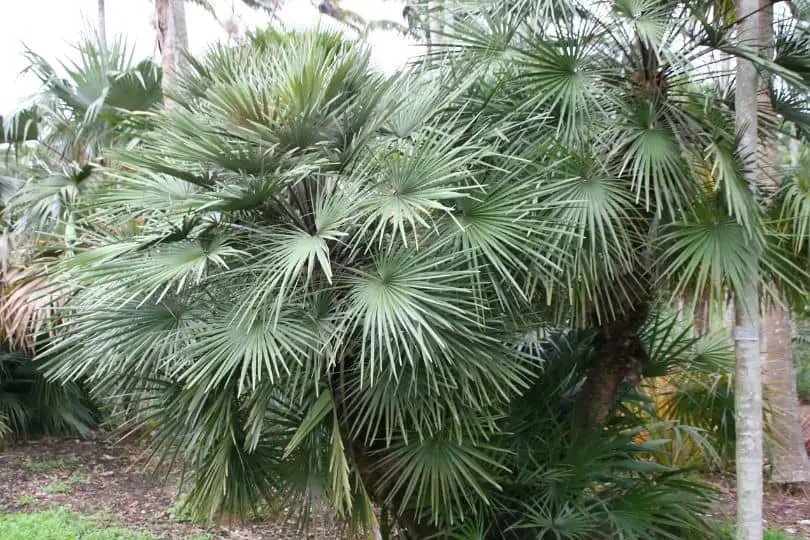
- Scientific Name: Chamaerops humilis
- Common Name(s): Mediterranean Fan Palm
- Mature Height: 6-15 feet (1.8-4.6 meters)
- Native Region: Mediterranean region
- Flowers: Creamy yellow flowers in clusters
- Fruit: Small, round, black or brown fruits
- Uses: Ornamental trees, used in landscaping, can be grown in containers or as a hedge plant
The Mediterranean Fan Palm (Chamaerops humilis) is a popular palm tree that may be seen in Georgia landscapes. It is a small to medium-sized palm tree that grows to a height of 6 to 15 feet. It is native to the Mediterranean region, making it ideal for Georgia’s climate.
The Mediterranean Fan Palm is distinguished by its fan-shaped, deep green leaves that are separated into many segments. The palm’s trunk is clothed with a fibrous, brown-gray bark that adds to its beauty.
In terms of blooms, the Mediterranean Fan Palm produces petite clusters of creamy yellow flowers. These blossoms are not extremely showy, but they provide an air of sophistication to the tree. Following the blossoms, the palm tree produces small, spherical black or brown fruits.
The Mediterranean Fan Palm thrives in well-drained soil and enjoys full sun to light shade while growing in Georgia environments. It is drought-tolerant, making it suited for Georgia’s occasionally hot and dry conditions. It can also grow in a variety of soil types.
Because of its appealing look and capacity to survive a variety of growth situations, the Mediterranean Fan Palm is often used in landscaping. It is an ornamental tree that adds a touch of refinement to any setting. It’s also popular in containers on patios and balconies. It can also be utilized as a hedge plant to create a natural and visually beautiful screen.
8. Canary Island Date Palm
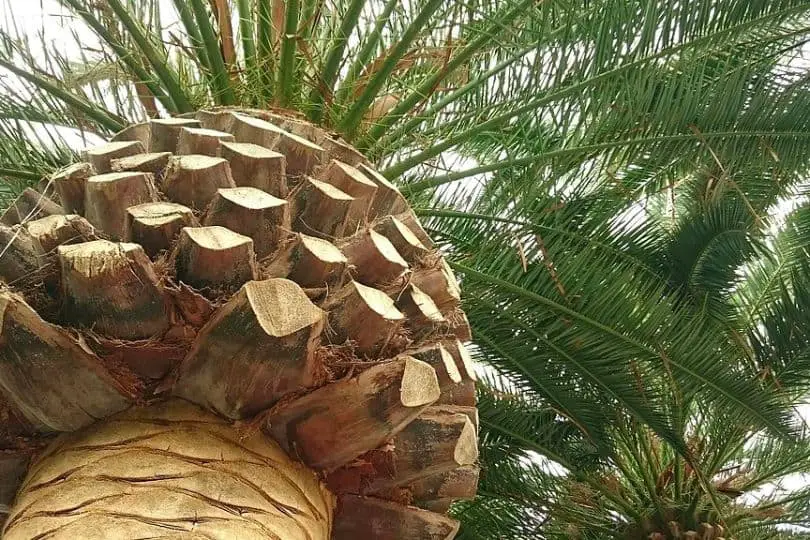
- Scientific Name: Phoenix canariensis
- Common Name(s): Canary Island Date Palm
- Mature Height: 50-60 feet (15-18 meters)
- Native Region: Canary Islands, off the coast of northwest Africa
- Flowers: Cream-colored flowers arranged in large clusters, appearing in late spring or early summer.
- Fruit: Small, oval-shaped, orange or reddish-brown dates.
- Uses: Ornamental tree for landscapes, provides shade and creates a tropical ambiance. Dates can be eaten but are not commonly consumed.
The Canary Island Date Palm (Phoenix canariensis) is a beautiful palm tree that can be seen in Georgia landscapes. The Canary Islands, off the coast of northwest Africa, are home to this palm species. Its remarkable height of 50 to 60 feet (15 to 18 meters) at maturity makes it a popular choice for landscaping.
The sturdy trunk of the Canary Island Date Palm is immediately recognizable by its diamond-shaped pattern generated by leaf scars. A thick canopy of tall, arching, pinnate leaves that can reach a length of 18 feet (5.5 meters) covers the trunk. The palm’s dark green leaves contain pointy, spiky leaflets that give it a striking appearance.
The Canary Island Date Palm blooms in late spring or early summer with huge clusters of cream-colored blossoms. These aromatic flowers attract a variety of pollinators. The palm yields little, oval-shaped dates after pollination. These dates are orange or reddish-brown in color and edible, however, they are rarely eaten.
Date palm trees in Georgia grow well in full light and well-drained soil. They are drought tolerant once grown, making them suited for Georgia’s climate. These palms are also salt tolerant, making them perfect for coastal environments. They can withstand brief periods of cold but may require protection during harsh frosts.
The Canary Island Date Palm is mostly utilized as an ornamental tree in Georgia. Its towering height and gorgeous crown of leaves give landscapes a tropical feel. These palms are frequently planted as specimen trees or as shade plants along roadways and avenues. The dates produced by this palm are not usually consumed, but they do offer an interesting decorative element to the tree. The Canary Island Date Palm, whether planted alone or in groups, offers a touch of elegance and grandeur to Georgia settings.
9. Saw Palmetto
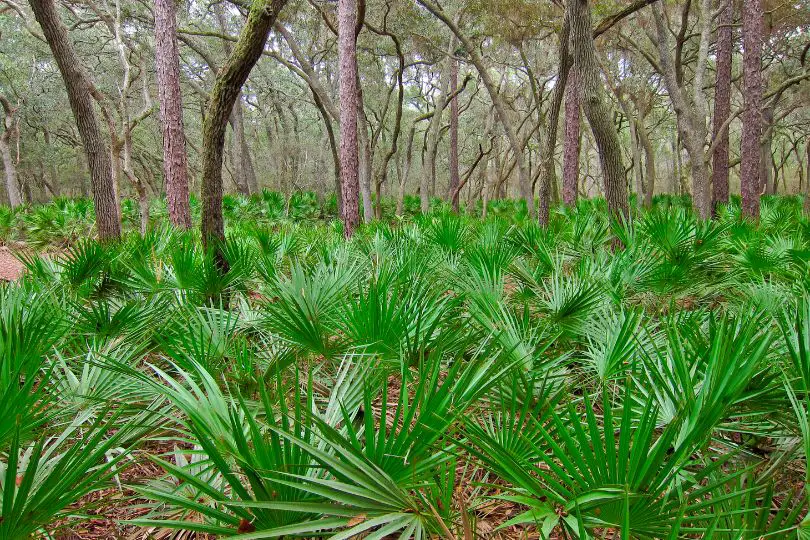
- Scientific Name: Serenoa repens
- Common Name(s): Saw Palmetto
- Mature Height: 6-10 feet (1.8-3 meters)
- Native Region: Southeastern United States, including Georgia
- Flowers: Yellowish-white, small, and inconspicuous flowers in clusters
- Fruit: Dark purple to black, round, and berry-like fruits
- Uses: Saw Palmetto is commonly used for its medicinal properties, mainly for treating benign prostatic hyperplasia (enlarged prostate). The fruits are harvested and processed to extract an oil, which is used in herbal remedies. The plant is also used for landscaping purposes due to its low maintenance and attractive foliage.
The Saw Palmetto (Serenoa repens) is a tiny palm tree found in Georgia landscapes. It grows to a height of 6 to 10 feet and has fan-shaped leaves that are 2-3 feet long. The trunk is normally low to the ground, with dark green leaves. Saw palmetto is native to the Southeastern United States, particularly Georgia, and has adapted well to the climate and soil conditions of the region.
Saw Palmetto is commonly found on sandy or well-drained soils in Georgia, particularly around the shore. It may grow in a variety of soil types but prefers acidic or slightly alkaline soils. It is also drought-tolerant and salt-tolerant, making it ideal for coastal environments.
Saw Palmetto has small, yellowish-white flowers that grow in groups. These flowers aren’t particularly showy and can be ignored. They are, however, followed by dark purple to black, spherical fruits. These berry-like fruits are a significant resource for biodiversity, attracting birds and small animals.
Saw Palmetto is well-known for its therapeutic effects in addition to its ecological value. The plant’s fruits are gathered and processed to produce an oil that is often used in herbal medicines. Saw Palmetto oil is mostly used in men to treat benign prostatic hyperplasia (enlarged prostate). It is thought to alleviate the symptoms of this disorder, such as frequent urination and urine flow issues.
Saw Palmetto is commonly used in landscaping because of its visually beautiful leaves and low maintenance requirements, in addition to its therapeutic applications. It is a popular choice for building naturalized or native plant gardens because it gives a touch of the natural beauty of the Southeastern United States to the area. Its small stature and ability to adapt to a variety of soil conditions make it an adaptable choice for Georgia gardens and urban environments.
9. Dwarf Palmetto
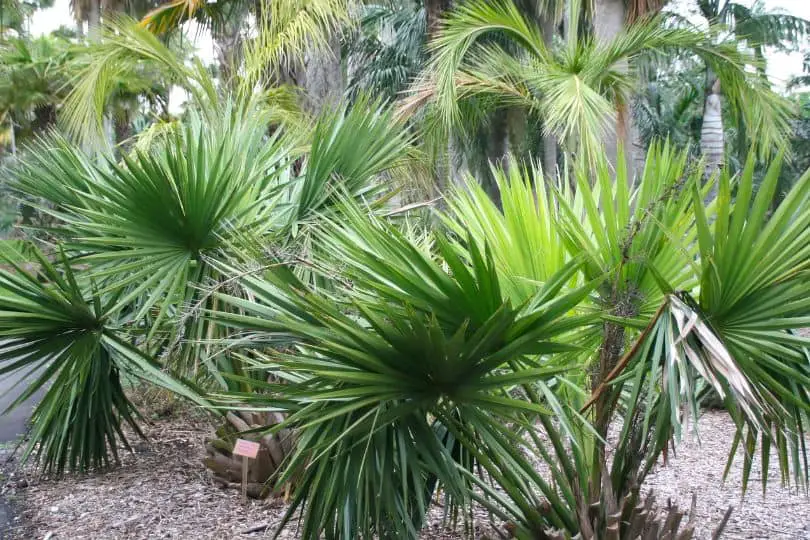
- Scientific Name: Sabal minor
- Common Name(s): Dwarf Palmetto, Blue Stem Palmetto
- Mature Height: 3-6 feet (0.9-1.8 meters)
- Native Region: Southeastern United States
- Flowers: Small, creamy white flowers arranged in clusters on branched stalks
- Fruit: Dark purple to blackberries
- Uses: Ornamental, providing a unique tropical look to landscapes
The Dwarf Palmetto (Sabal minor) is a small, clumping palm tree that is abundant in Georgia landscapes. It grows to a height of 3-6 feet (0.9-1.8 meters) and has a thick trunk coated in a dense coating of old leaf bases, giving it a rough appearance. Its leaves are fan-shaped and can grow to be 3-4 feet (0.9-1.2 meters) long with several segments.
The Dwarf Palmetto is native to the southeastern United States, particularly Georgia, and is well-adapted to the region’s climate and soil conditions. It grows natively in moist woodlands, wetlands, and along river banks. It flourishes on moist, well-drained soils with partial to full sun exposure in the landscape.
The Dwarf Palmetto blooms in late spring to early summer, with small, creamy white flowers placed in clusters on branched stalks that emerge from the heart of the palm’s leaf. These flowers are fragrant and appealing to bees and other pollinators. The blossoms give place to dark purple to black berries, which are an important source of food for wildlife.
The Dwarf Palmetto is a versatile palm tree that can be used in Georgia landscaping as an ornamental plant. Its distinct tropical appearance adds aesthetic appeal and diversity to gardens, and its compact stature makes it ideal for tiny places. It looks beautiful when combined with other native plants and can be planted in groups or individually.
11. Pindo Palm
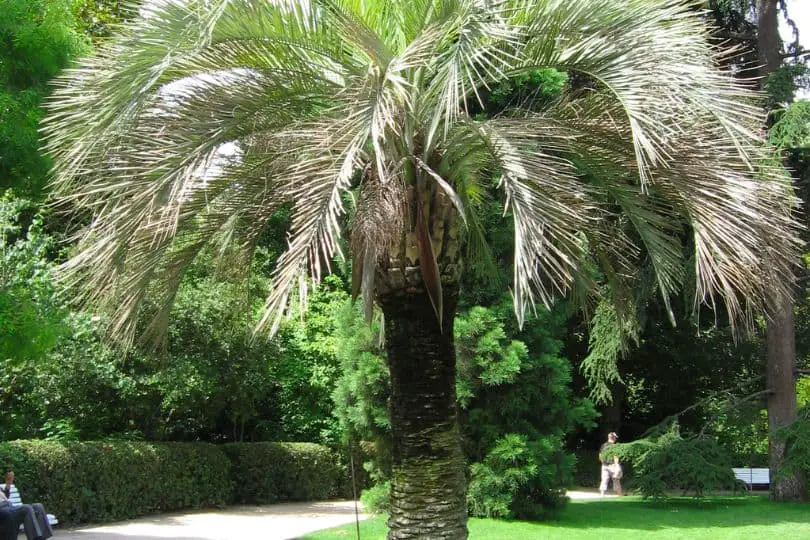
- Scientific Name: Butia capitata
- Common Name(s): Pindo Palm, Jelly Palm
- Mature Height: 15-25 feet (4.5-7.5 meters)
- Native Region: South America
- Flowers: Yellow/cream-colored, tubular-shaped flowers
- Fruit: Orange-yellow edible fruits, often used to make jelly or wine
- Uses: Pindo palms are commonly used as ornamental plants in landscapes due to their attractive appearance. The fruits can be harvested and used to make jams, jellies, and wines. The leaves of the tree are sometimes used for thatch roofs or woven into baskets. It is also a popular choice for coastal landscapes due to its salt tolerance.
The Pindo Palm, also known as the Jelly Palm, is a medium-sized palm tree that grows to be 15-25 feet tall when mature. It is endemic to South America and can be found in Georgia landscapes.
The Pindo Palm has feathery leaves that grow in a symmetrical pattern. The leaves are bluish-gray and can grow up to six feet long. The tree’s trunk is covered in fibrous, brownish-gray bark.
The Pindo Palm blooms in the spring and summer with yellow or cream-colored tubular flowers. These little but fragrant blossoms attract bees and other pollinators. The tree produces orange-yellow edible fruits that resemble miniature coconuts in the fall. These delicious and flavorful fruits are frequently used to produce jelly or wine.
Because it can survive a wide range of soil conditions, including sandy and clay soils, the Pindo Palm is well-suited for Georgia landscapes. It is also extremely salt tolerant, making it a popular choice for coastal settings. The tree enjoys direct sunlight but will tolerate slight shade. Once grown, it is very drought-tolerant but will benefit from regular watering, especially during hot and dry months.
In addition to its decorative appeal, the Pindo Palm offers several utilitarian applications. The tree’s fruits can be collected and turned into jams, jellies, and wines. The tree’s leaves are sometimes used to make thatch roofs or weaved into baskets.
12. Mule Palm
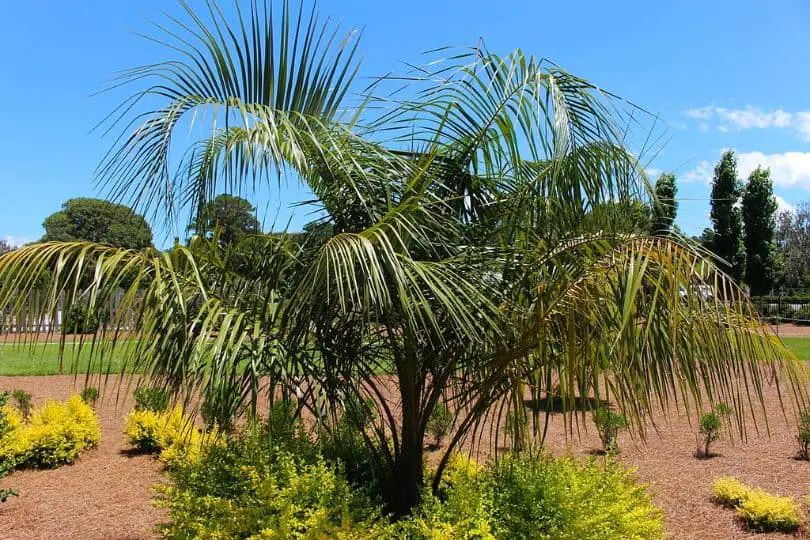
- Scientific Name: Butia capitata x Syagrus romanzoffiana
- Common Name(s): Mule Palm
- Mature Height: 20-30 feet (6-9 meters)
- Native Region: Hybrid palm tree (originated from a cross between Butia capitata and Syagrus romanzoffiana)
- Flowers: Small yellow flowers arranged in clusters on branched inflorescences
- Fruit: Small, round, or oval-shaped fruits that turn dark purple when ripe
- Uses: Ornamental tree, landscape palm
The Mule Palm (Butia capitata x Syagrus romanzoffiana) is a hybrid palm tree that resulted from a cross between Butia capitata and Syagrus romanzoffiana. It is commonly employed as an ornamental tree in landscapes due to its tall and slender trunk, which can grow to a mature height of 20-30 feet (6-9 meters).
The Mule Palm has long, feathery leaves that are arched and pinnate in hue and are blue-green in appearance. The stem of the palm is usually covered with persistent leaf bases, has a smooth texture, and is grayish-brown in color. This palm tree has little yellow blooms that grow in groups on branched inflorescences. It should be noted, however, that the Mule Palm does not flower on a regular basis in some areas.
When it comes to fruit, the Mule Palm produces small, round, or oval-shaped fruits that turn a dark purple color when ripe. These fruits are edible and have a pleasant flavor. They are, however, mostly liked by wildlife such as birds and squirrels.
The Mule Palm grows in full sun and requires well-draining soil in Georgia environments. It is a tough palm that can withstand temperatures as low as 10°F (-12°C). It is also drought tolerant, making it appropriate for Georgia’s climate. This palm is frequently utilized in landscape designs to add a tropical and exotic touch to gardens, parks, and residential spaces. Its exquisite design, combined with its adaptability to different soil types, makes it a favorite option among gardening aficionados.
13. Sago Palm
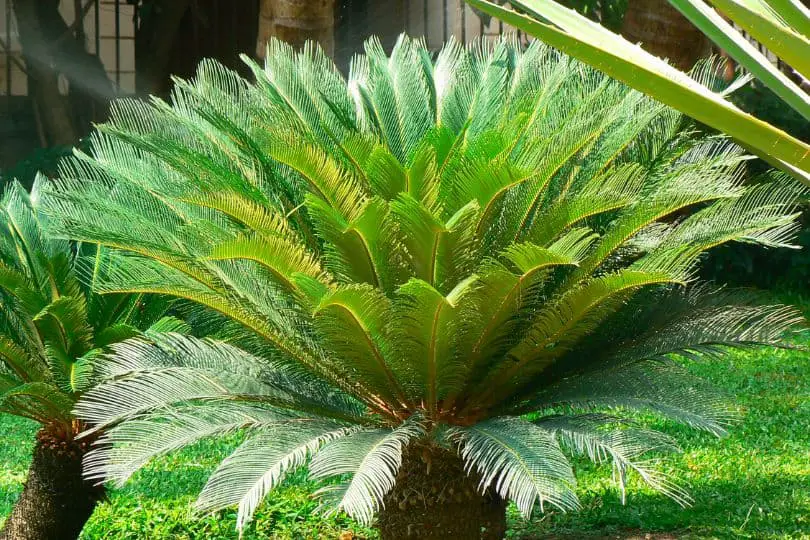
- Scientific Name: Cycas revoluta
- Common Name(s): Sago Palm, Japanese Sago Palm
- Mature Height: 10-12 feet (3-3.6 meters)
- Native Region: Japan
- Flowers: No Flowers
- Fruit: Orange to red cones
- Uses: Ornamental plants for landscaping, interior decoration, and container gardening. The seeds of the Sago Palm are also used in culinary preparations in some cultures.
The Sago Palm, also known scientifically as Cycas revoluta, is a popular and common palm tree in Georgia settings. It is sometimes referred to as the Japanese Sago Palm. This slow-growing palm can reach a mature height of 10-12 feet and has a crown of huge, fluffy leaves up to 4-5 feet long.
The Sago Palm, which is native to Japan, is frequently cultivated for its decorative appeal. It is a common landscaping material in Georgia, particularly in tropical and subtropical areas. Its strong and appealing appearance makes it a popular choice for bringing a touch of exotic elegance to gardens and outdoor spaces.
The long, arching leaves of the Sago Palm radiate from a central point, giving it a distinct and beautiful appearance. The palm’s short, strong trunk is covered with rough, brown bark. The Sago Palm, unlike many other palm trees in Georgia, lacks a true trunk and instead has a canopy of leaves that rises directly from the ground.
The Sago Palm does not produce blooms, but it does create cone-like structures that house the seeds. These cones range in hue from orange to red and are highly eye-catching. It should be noted, however, that all parts of the Sago Palm, including the seeds, are harmful to humans and animals if consumed.
The Sago Palm prefers well-drained soil and thrives in partial shade to full sun for growth. Once planted, it is drought-tolerant and requires little care. It is, however, frost-sensitive and should be sheltered during freezing weather. The Sago Palm is a durable and long-lived tree that can tolerate a wide range of soil conditions, making it suited for a variety of Georgia environments.
In Georgia, the Sago Palm is mostly utilized as an ornamental plant. It adds a tropical flair to gardens, patios, and indoor settings. Its architectural beauty and low-maintenance nature make it an excellent choice for both expert and novice gardeners. Furthermore, the Sago Palm seeds are employed in culinary preparations in various civilizations, albeit caution is advised due to their toxic nature.
14. Mexican Fan Palm
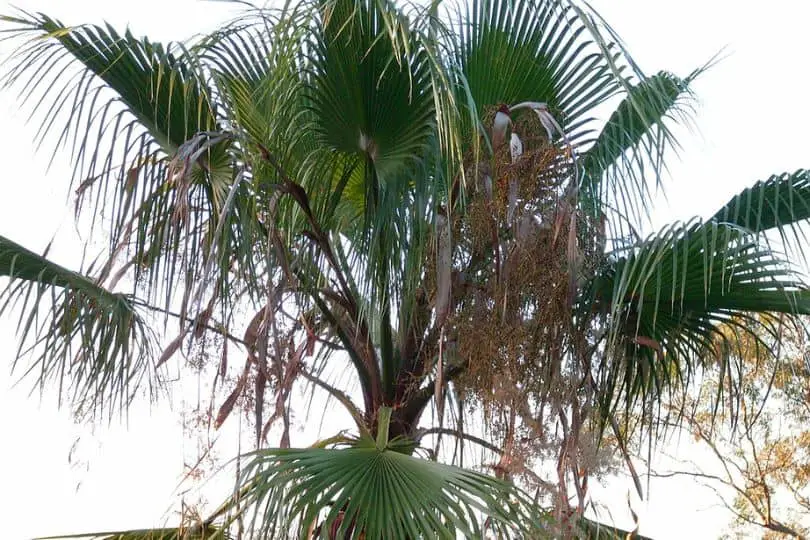
- Scientific Name: Washingtonia robusta
- Common Name(s): Mexican Fan Palm
- Mature Height: 50-80 feet (15-24 meters)
- Native Region: Mexico
- Flowers: Cream-colored, small flowers arranged in clusters
- Fruit: Small, round orange-brown fruit
- Uses: Ornamental tree, provides shade, used in landscaping and urban areas
The Mexican Fan Palm, scientifically known as Washingtonia robusta, can be found across Georgia. It is a tall and thin palm tree that can grow to be 50-80 feet (15-24 meters) tall when mature. This species is native to Mexico, but it has been widely cultivated around the world, including Georgia.
The Mexican Fan Palm is distinguished by its fan-shaped leaves with multiple segments. This palm tree’s trunk is smooth and greyish-brown in color, with a diamond-shaped pattern formed by the remains of ancient leaf bases. It is a fast-growing palm tree that may bring a tropical feel to any scene.
The Mexican Fan Palm grows in Georgia in full sun and well-drained soil. It is drought-tolerant and can resist light frost, making it suited for the climate of the state. Because of its ornamental value and ability to give shade, this palm tree is often employed in landscaping projects, urban areas, and parks. It provides a sense of sophistication to any outdoor setting.
Mexican Fan Palm trees in Georgia bloom in the spring with small cream-colored flowers clustered in clusters. Small, spherical orange-brown fruits develop from these flowers. The greatest attraction of this palm tree, however, is its gorgeous leaf and general beauty.
15. Chinese Fan Palm
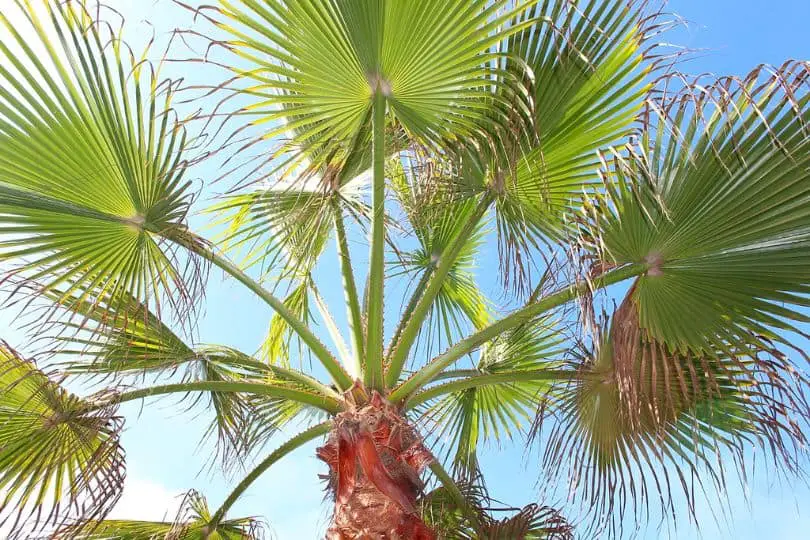
- Scientific Name: Livistona chinensis
- Common Name(s): Chinese Fan Palm, Fountain Palm
- Mature Height: 25-50 feet (7.6-15 meters)
- Native Region: East Asia, specifically southern Japan, southern China, and Taiwan.
- Flowers: Creamy white, small, inconspicuous flowers.
- Fruit: Small black or dark purple berries.
- Uses: Ornamental trees in landscapes and gardens, can be grown in containers indoors or outdoors.
The Livistona chinensis, often known as the Chinese Fan Palm, is a popular choice for landscaping in Georgia and other warm regions. It is a tall palm tree with a spread of 10 to 15 feet and a height of 25 to 50 feet. Its trunk is slender and gray-brown in hue, with old leaf bases covering it, giving it a rough appearance.
The Chinese Fan Palm’s leaves are big and fan-shaped, with deeply separated segments. They can grow to be up to 6 feet long and have a shiny, dark green color. Long, arching petioles hold the leaves in place, creating a lovely canopy. This palm tree is noted for its resistance to a variety of soil types, including clay, loam, and sand, which makes it flexible and well-suited for Georgia environments.
The Chinese Fan Palm is a subtropical and tropical plant endemic to East Asia, specifically southern Japan, southern China, and Taiwan. It thrives in USDA hardiness zones 9 to 11, which cover most of Georgia. It loves full sun to partial shade and can endure temperatures as low as 20°F (-6°C).
The Chinese Fan Palm blooms in late spring or early summer, with small, creamy white flowers held on spiky inflorescences. The flowers aren’t particularly attractive, but they do give way to little black or dark purple berries that attract birds and wildlife. These fruits are not suitable for human consumption.
Because of their lovely look and capacity to give shade, Chinese Fan Palms are widely employed as ornamental trees in landscapes. They lend a tropical flair to gardens and can be planted in huge containers indoors or out. They are appropriate for confined places due to their tall and slender appearance, and they function well as a focal point or accent tree.
Similar Articles
- Native Oak Trees in Georgia
- Native Pine Trees In Georgia
- Native Hickory Trees In Georgia
- Native Maple Trees In Georgia
- Native Tupelo Trees In Georgia
- Native Plum Trees In Georgia
- Native Magnolia Trees In Georgia
- Native Willow Trees In Georgia
- Native Ash Trees In Georgia
- Native Elm Trees In Georgia
- Native Dogwood Trees In Georgia
- Native Cottonwood Trees In Georgia
- Native Cedar Trees In Georgia
- Common Birch Trees In Georgia
- Common Cypress Trees In Georgia
- Common White Flowering Trees In Georgia
- Common Pink Flowering Trees In Georgia
Common Palm Trees In Georgia – Sources
The Regional Gardening team makes sure that the information in our articles is accurate by only using sources that are known to be trustworthy. Some of these sources are peer-reviewed journals from government agencies, well-known universities, and scientific research organizations.
- Georgia Native Plant Society
- College Of Agricultural & Environmental Sciences, University Of Georgia
- Native Plants Books, Georgia Native Plant Society
- Georgia Forestry Commission
- Native Plants Of North Georgia, University Of Georgia
- Tree Care, Georgia Tree Council


